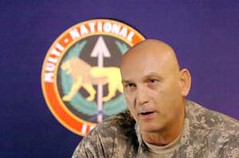 From the NewsHour Thursday night:
From the NewsHour Thursday night:
Jim Lehrer: In Baghdad, Army Lt. Gen. Ray Odierno said militants are trying new tactics, including the rash of attacks on helicopters.
Odierno: I think we see in a few cases, two maybe three of the cases, that there were probably some sort of ambush sites that were set up by some of our foes. We are studying those intently, we’re trying to learn from those, and we will learn from those, and we will adapt our tactics.
Lehrer: The general said U.S. forces have captured two members of a cell involved in the helicopter attacks.
In “For Success in Iraq, U.S. Forces Must Out-Innovate Insurgents,” Guy Ben-Ari and Shawn Brimley this week highlighted the need for innovation in response to the new insurgent tactics indicated by the spate of helicopter shoot-downs:
These cycles of innovation prove that the enemy in Iraq is highly adaptive, firmly linking strategies and tactics to perceived American vulnerabilities. This is no different from Vietnam, Afghanistan, Somalia and last summer’s war in Lebanon, all of which show that small, networked insurgent groups can often interpret events, develop innovative solutions, and deploy new capabilities and tactics much quicker than their adversaries. The new Army/Marine Corps counterinsurgency manual is clear on the need to constantly innovate, concluding that “victory is gained through a tempo or rhythm of adaptation that is beyond the other side’s ability to achieve or sustain.” . . .
During irregular warfare, there remains no alternative in responding to enemy innovation and asymmetric tactics than to simply innovate faster and more effectively. The late Col. John Boyd, when writing on the theory of air combat, conceived of what he termed an OODA (Observe, Orient, Decide, Act) loop. The ability to “get inside” an adversary’s OODA loop is an overriding factor in determining who lives to fight another day, according to Boyd. When confronting a thinking and adaptive enemy, employing faster and tighter innovation cycles will save American and coalition lives.
Sounds like Lt. Gen. Odierno, who is commander of the Multi-National Force Iraq, understands the necessity of getting inside the insurgents’ “OODA loop.” That’s good news.
(One gripe: Why can’t the MNF-I’s public affairs operation innovate in its tactics? After all, Iraq is nothing if not a war of influence and ideas. And yet, the only mention of Odierno’s press conference on the MNF-I Web site is this “news story” from MNF-I public affairs, which manages to avoid reporting anything interesting Odierno said. Perhaps we’ve become too obsessed with video of late, but if we were running MNF-I PA, we’d post a copy of the video of every press conference on our site, and also post it to YouTube, so blogs like this one could show it directly.)
UPDATE: MNF-I public affairs, in a very quick response to my email inquiry, sent me a copy of the transcript. And I subsequently discovered the transcript is online at the main DOD site.
